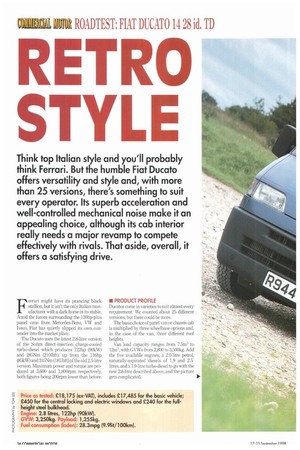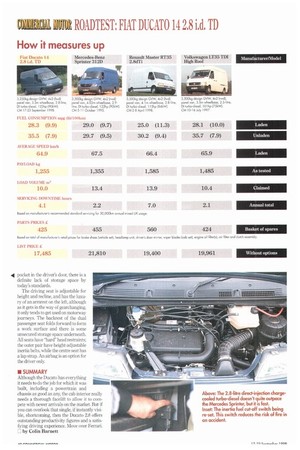ROADTEST: FIAT DUCATO 14 28 id. ID
Page 38

Page 40

Page 42

If you've noticed an error in this article please click here to report it so we can fix it.
Think top Italian siyle and you/11 probably think Ferrari. But the humble Fiat Ducat° offers versatility and style and, with more than 25 versions, there's something to suit every operator. Its superb acceleration and well-controlled mechanical noise make it an appealing choice, although its cab interior really needs a major revamp to compete effectively with rivals. That aside, overall, it offers a satisfying drive.
Ferrari might have its prancing black stallion, but it isn't the only Italian manufacturer with a dark horse in its stable. Amid the furore surrounding the 120hp-plus pane] vans from Mercedes-Benz, VW and Iveco, Fiat has quietly slipped its own contender into the market place.
The Ducat° uses the latest 2.8-litre version of the Sofim direct-injection charge-cooled turbo-diesel which produces 122hp (90kVv) and 285Nm (2101bft), up from the 116hp (85k174) and 245Nm (1811bft) of the old 2.5-litre version. Maximum power and torque are produced at 3,600 and 1,800rpm respectively, both figures being 200rpm lower than before. • PRODUCT PROFILE
Ducatos come in varieties to suit almost every requirement. We counted about 25 different versions, but there could be more.
The basic choice of panel van or chassis cab is multiplied by three wheelbase options and, in the case of the van, three different roof heights
Van load capacity ranges from 7.5m3 to 12m3, with GVWs from 2,800 to 3,500kg. Add the five available engines, a 2.0-litre petrol, naturally-aspirated diesels of 1.9 and 2.5litres, and a 1.9.1itre turbo.diesel to go with the new 2.8-litre described above, and the picture gets complicated. • PRODUCTIVITY The medium wheelbase, highroof version tested contains 10m3 of load volume with a floor area of 4.8m2. A small amount of over-cab space is provided, although the material used to line the space produced an annoying creak. The full-height glazed steel bulkhead is a paragon of silence by comparison. Although six load-restraint points are provided, they are a flimsy looking "bent wire" design. The rear doors have a robust double-locking mechanism, but are only fitted with 90° hinges.
While most of its 120hp rivals are plated at 3,500kg, the medium wheelbase Ducato tested was running at only 3,250kg GVW. Consequently its net payload of 1,255kg, which is further reduced by the sturdy bulkhead, appears unimpressive by comparison. If you need a 3,500kg Ducato, you have to go to the Maxi I.WB version. The Ducato's laden fuel consumption figure of 28.3mpg (9.91it/100km) is up with the best, while its unladen 35.5mpg (7.91it/1001(m) is unmatched by any of its similarly powered rivals.
Security is assisted by the unglazed rear doors (a no-cost option) and a passive engine immobiliser. This uses Fiat's infamous system whereby much of the vehicle's diagnostic function is contained within the red master key—which costs a small fortune to replace, so don't lose it. An inertia-operated fuel cutoff switch is fitted to reduce the risk of fire in an acccident.
• ON THE ROAD
The Ducato's cold start characteristics are excellent, with the glow-plug lamp going out as fast as the key could be turned. However, the first 30 seconds after start-up on our test van were accompanied by squeals from the engine's drive belts. Moving off revealed a long travel clutch pedal with the biting point at the very bottom.
In the acceleration stakes, the Ducato outruns all its rivals apart from the Sprinter 312D, although the Italian Job is helped by its quarter-tonne advantage. It is quick, but with
out the Merc's feeling of raw power. The last Sevel variant we tested was a Peugeot Boxer (CM 12-18 March) which we criticised for its mismatch between gear ratios and engine characteristics. No such moans about the Ducato, which shares the same ratios, although with a taller final drive, but fills the gaps better with its greater torque produced at lower revs.
The gear change was less precise than in previously tested Sevels, although the Boxer's problem with a lack of clearance between gear lever and steering wheel seems to have gone away, despite the components appearing identical.
One downside to all that torque combined with driven front wheels, is that some restraint is needed to avoid wheelspin and torque steer. In all other respects the Ducato's road manners are impeccable, Ride is satisfactory while its handling proved sharp and stable in all the conditions we encountered, laden and empty.
Mechanical noise was well controlled, being largely drowned out by a considerable amount of wind roar and tyre hiss. The driver's door mirror had an annoying vibration problem, while visibility is further reduced by the thick A pillars.
• CAB COMFORT The cab is a rather gloomy place, with grey tartan seats, grey trim, roof and dash and black sun visors. Even the body-coloured door frames on oinf dark test van added to the gloom, brightened only by an irritating reflection of passing white lines. The rather basic instrument panel contains just the three dials; to get the best out of the current crop of high powered turbo-diesels, rev-counters really should be included. The usual Sevel digital clock is fitted where it's hidden by the driver's left hand on the steering wheel.
The dash-mounted switchgear and heater controls are large and easy to use, but the column stalks are moulded plastic with hollowed -out backs, and feel decidedly low rent. The electric windows don't have one-touch operation, but make up for it with their speed. The wipers work well enough, although there's enough room for the driver's side blade to be an inch longer at each end. The permanently live radio wiring is a rarely seen, though much appreciated, touch for any driver who spends a full working day in the van.
Although the dash has a few nooks and crannies, including a glove box—which still has too short a string to let the lid mounted cup recesses reach the horizontal—and a pocket in the driver's door, there is a definite lack of storage space by today's standards.
The driving seat is adjustable for height and recline, and has the luxury of an armrest on the left, although as it gets in the way of gearchanging, it only tends to get used on motorway journeys. The backrest of the dual passenger seat folds forward to form a work surface and there is some unsecured storage space underneath. All seats have "hard" head restraints; the outer pair have height-adjustable inertia belts, while the centre seat has a lap strap. An airbag is an option for the driver only.
• SUMMARY Although the Ducat° has everything it needs to do the job for which it was built, including a powertrain and chassis as good as any, the cab interior really needs a thorough facelift to allow it to compete with newer arrivals on the market But if you can overlook that single, if instantly visible, shortcoming, then the Ducato 2.8 offers outstanding productivity figures and a satisfying driving experience. Move over Ferrari. 0 by Colin Barnett




























































































































